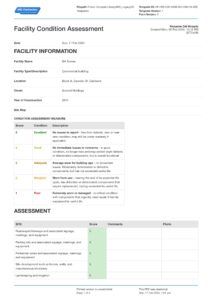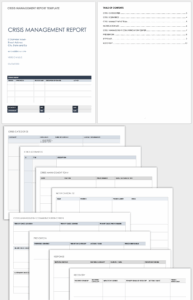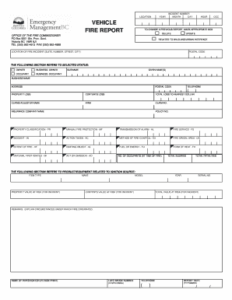Understanding the available water supply for fire protection is absolutely critical for public safety and the integrity of buildings. Hydrant flow tests are essential for assessing water system performance, ensuring that there’s adequate pressure and volume in case of an emergency. These tests provide invaluable data that informs urban planning, fire department operations, and the design of fire suppression systems.
However, merely conducting the test isn’t enough. The real value comes from accurately documenting the findings. A well-structured report ensures that all the crucial information is captured, easy to interpret, and readily available for future reference or regulatory compliance. Without proper documentation, even the most meticulously performed test can lose its impact and utility.

That’s where a standardized hydrant flow test report template becomes indispensable. It serves as a comprehensive guide, making sure no vital detail is overlooked and that all tests are recorded consistently. Whether you’re a municipal water utility, a fire protection consultant, or a building owner, having a reliable template streamlines your reporting process and enhances data accuracy across the board.
What to Include in Your Hydrant Flow Test Report Template
Creating an effective hydrant flow test report template means thinking about all the pieces of information someone might need to understand the test, its conditions, and its results. It’s about building a narrative around the numbers, ensuring clarity and context. This isn’t just a simple data dump; it’s a critical document that can have significant implications for public safety and infrastructure planning. From the initial setup to the final recommendations, every section plays a vital role in painting a complete picture of the water supply conditions.
First and foremost, the template should always start with general project and site information. This includes the client’s name, the project number, and the full address of the test location. It’s also crucial to record the date and time of the test, as water demands can fluctuate throughout the day. Identifying the individuals who performed the test, along with their qualifications or certifications, adds a layer of credibility and accountability to the report. You might also want to include the specific purpose of the test, whether it’s for a new development, routine maintenance, or an investigation into low pressure complaints.
Next, you’ll need to detail the environmental conditions present during the test. Weather can sometimes influence results, so noting the ambient temperature and any significant weather events like heavy rain or snow is a good practice. It’s also important to specify the exact hydrants used for the test, including their unique identification numbers or precise geographical coordinates. A clear sketch or map showing the location of the flow hydrant and the residual hydrants is highly beneficial for anyone reviewing the report, especially if they are unfamiliar with the site.
Key Sections for Accurate Reporting
To truly be comprehensive, a robust hydrant flow test report template must break down the technical aspects into understandable components. This ensures that the data collected is consistent and comparable across different tests and locations.
- Equipment Used: List all the instruments involved in the test, such as pressure gauges (pitot and static), flow nozzles, and any data logging devices. Include calibration dates for these instruments to demonstrate their accuracy.
- Test Procedure: Briefly describe the methodology followed, referencing any relevant standards (e.g., NFPA 291). This confirms that the test was conducted according to accepted industry practices.
- Static Pressure: Record the initial static pressure reading at the residual hydrant before any water is discharged.
- Residual Pressure: Note the pressure at the residual hydrant while water is flowing from the flow hydrant.
- Pitot Pressure: Capture the dynamic pressure measured at the outlet of the flow hydrant to determine the flow rate.
- Flow Rate: Calculate and record the actual flow rate in gallons per minute (GPM) or liters per minute (LPM) based on the pitot pressure.
- Observations: Document any unusual conditions observed during the test, such as discolored water, unusual noises, or problems with the hydrant itself. These qualitative observations can provide valuable context to the quantitative data.
- Recommendations: Based on the test results, provide any necessary recommendations, such as further investigation into low pressure, hydrant maintenance, or system upgrades.
Finally, the report should always conclude with a clear summary of the findings and any professional opinions or interpretations. This includes extrapolating the available water at 20 psi or other minimum required residual pressures, which is a common requirement for fire protection system design. A space for signatures from the testing personnel and a client representative, if applicable, solidifies the document’s authenticity.
Why a Standardized Hydrant Flow Test Report Template Matters
Adopting a standardized hydrant flow test report template offers numerous advantages beyond just organized data. It fosters consistency across all testing operations, ensuring that whether tests are conducted by different teams or at different times, the reported information is structured in a uniform manner. This uniformity is crucial for comparative analysis, allowing for easier identification of trends, potential system degradation, or improvements over time. Imagine trying to compare data from a decade ago if every report was formatted differently; it would be a logistical nightmare.
Furthermore, a well-designed template significantly aids in regulatory compliance. Many jurisdictions and industry standards, like those set by NFPA, require specific data points to be recorded during fire protection system testing. A template acts as a built-in checklist, helping to ensure that all mandatory information is captured, thereby reducing the risk of non-compliance issues and potential penalties. It simplifies audits and inspections, providing clear, concise evidence of due diligence.
Beyond compliance, a consistent reporting structure improves communication among stakeholders. Fire departments can quickly grasp the water availability in their service areas, engineers can design systems with accurate flow data, and property owners can understand the implications for their insurance or safety protocols. It turns raw data into actionable insights, making the entire process more efficient and transparent for everyone involved.
The systematic use of a clear and comprehensive hydrant flow test report template elevates the quality of data collection and reporting. It transforms a routine technical task into a robust information management process, providing a strong foundation for critical decision-making related to fire safety and water infrastructure. This dedication to detailed and consistent reporting ultimately contributes to safer communities and more resilient water systems for the long term.



